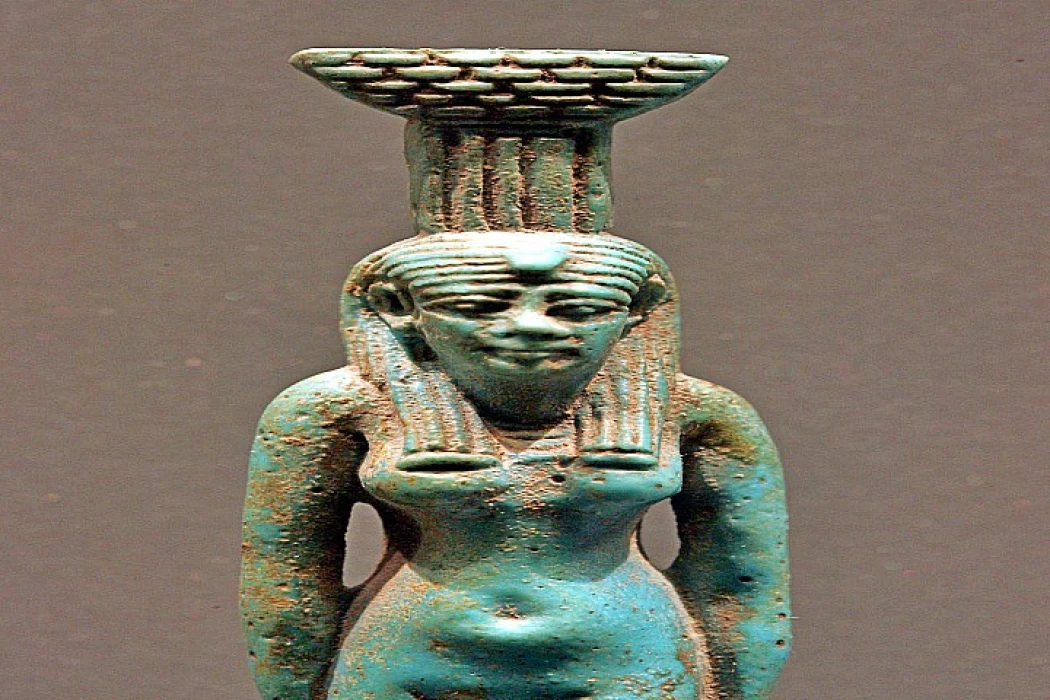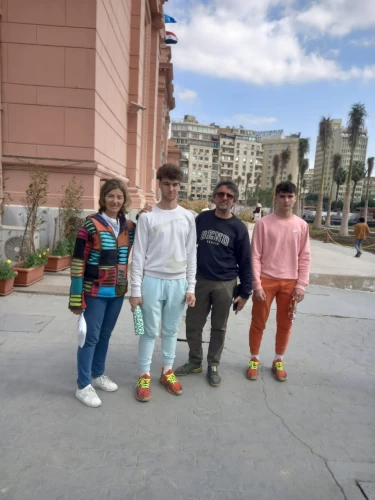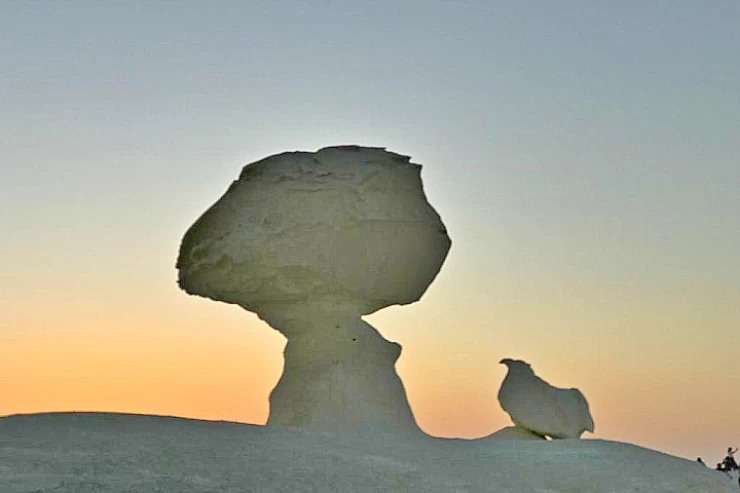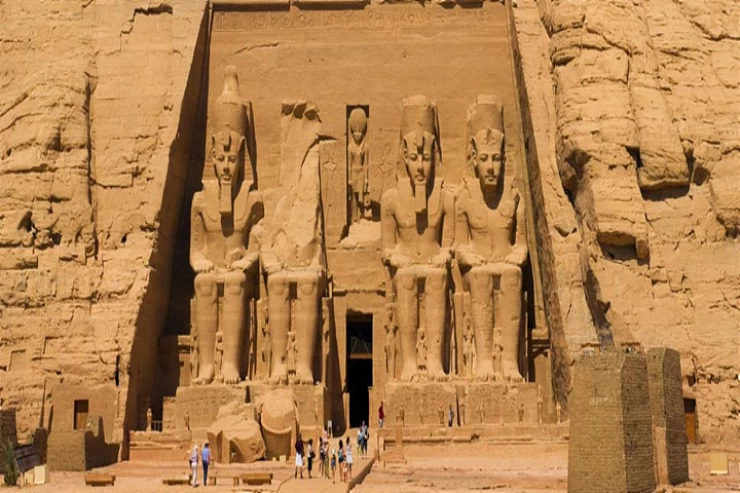
Déesse Nephthys | Maîtresse de la maison | Déesse de l'air dans l'Égypte ancienne
Déesse Nephthys, Maîtresse de la maison et Déesse de l'air dans l'Égypte ancienne
Nephthys, une déesse égyptienne, fille de Geb et Nut, sœur d'Isis, Osiris et Seth. La qualité à peine significative de son nom suggérait que, la déesse n'était rien de plus qu'une création du mythe, destiné à donner à Seth un compagnon en parallèle de le couple Isis-Osiris. Comme elle n'apparaît jamais séparée d'Isis, il est probable qu'elle soit même doublée. Que l'union avec Seth soit une élaboration ultérieure du mythe, née du désir d'avoir deux couples divins symétriques, est également démontré par le fait que Nephthys, en tant qu'épouse de Seth, apparaît terne. Nephtys a une apparence tout à fait humaine et n'est reconnaissable qu'au symbole hiéroglyphique de son nom, sur sa tête (le plan d'un édifice surmonté d'une corbeille). Sous cet aspect, Nephtys apparaît, toujours en union avec Isis, à côté du cadavre d'Osiris (et tout défunt devient un Osiris, ayant ainsi droit aux soins des deux divinités).
Dans les scènes de l'au-delà, elle apparaît également, toujours en union avec Isis, aux côtés d'Osiris, représenté soit sur le trône en tant que dieu des morts, soit sous l'aspect du serpent, gardant la dernière porte du monde souterrain par laquelle le soleil reviendra sur terre. Ces scènes sont très fréquentes sur les murs des tombes, les scènes funéraires et les papyrus, et se retrouvent parfois sur les petits côtés des sarcophages, protégeant Isis la chef et Nephtys. Il ne fait aucun doute que le culte de Nephtys existait dans le temple et dans la grande cité d'Héracléopolis. Une statue grandeur nature de Nephtys (aujourd'hui conservée au musée du Louvre) présente une inscription curieusement modifiée. L'image en basalte était à l'origine placée à Medinet Habu, dans le cadre de la célébration de la tradition pharaonique de la fête de Sed, mais elle a été déplacée à Hérakléopolis à un moment donné.
Voyagez en Égypte pour visiter les temples et les pyramides égyptiennes et en apprendre davantage sur la mythologie et les centaines de divinités vénérées par les pharaons. Qui ressemblaient beaucoup aux humains qui aimaient et haïssaient, ressentaient de la jalousie, se battaient et mouraient au cours d'un mythe incroyable rempli de joie, de drame et d'action qui a inspiré les réalisateurs et les producteurs de films modernes à créer des films mondialement connus sur la grandeur des pharaons et des dieux qu'ils vénéraient. Passez quelques jours à visiter Abydos, Gizeh, Louxor et Assouan pour visiter les tombes des pharaons ornées de scènes très claires, détaillées et magnifiquement peintes des différents dieux de l'Égypte ancienne, ainsi que de nombreux autres sites. Si vous prévoyez de visiter l'Égypte, vous devriez envisager de consulter notre guide de voyage détaillé sur l'Égypte, car il s'agit d'une expérience très unique lors des visites en Égypte qui n'est comparable à aucune autre chose à faire en Égypte. Vous pouvez profiter de l'un des circuits classiques en Égypte, que tous les voyageurs aimeraient faire une croisière sur le Nil lors des Tours de Noël en Egypteou sous le meilleur temps lors des circuits de Pâques en Égypte. Couvrant la plupart des excursions d'une journée au Caire, des excursions d'une journée à Louxor en plus des excursions à Assouan. C'est pourquoi notre section d'informations sur les voyages est destinée à être utile avant de procéder aux meilleures excursions en Égypte pour ceux qui recherchent la culture, l'histoire de l'Égypte et un hébergement luxueux tout en naviguant sur le Nil dans la Vallée.
Naviguez sur les eaux bleues à travers les deux bandes verdoyantes de part et d'autre du désert doré lorsque vous réservez votre croisière sur le Nil égyptien. Et consultez nos offres saisonnières pour choisir la pension ou la maison de vacances la plus adaptée à vos vacances de Pâques 2023. Nous vous épargnerons les tracas et inclurons certains des meilleurs hôtels et bateaux dans toutes les villes que vous allez visiter par le biais de forfaits de voyage en Égypte. Mais si vous aimez réserver votre propre hôtel, nous avons professionnellement personnalisé une grande variété d'excursions d'une journée en Égypte pour vous. Commencez dans la ville qui ne dort jamais et explorez nos excursions d'une journée au Caire qui couvrent tous les sites archéologiques et les lieux de divertissement à partir des pyramides de Gizeh, le célèbre Sphinx et au Musée égyptien situé sur la place El Tahrir et le Musée national de la civilisation égyptienne pour admirer le masque d'or du roi Toutankhamon. Et si vous avez envie de camper dans l'un des déserts les plus fascinants du monde, nous avons créé les circuits du désert blanc. Voyagez en toute sécurité avec nous en Haute-Égypte et réservez nos excursions d'une journée à Louxor et voyagez plus au Sud vers l'étonnante Nubie et explorez toutes les options que nos excursions d'une journée à Assouan peuvent vous offrir.
Nephthys is literally the mistress of the house. She is one of the chief but most enigmatic deities as far as Egyptian mythology is concerned. She has a very important place in the divine pantheon, although she is always overshadowed by her more famous sister, Isis. A goddess of protection, mourning, and the afterlife, Nephthys most closely relates to death and the transformation or transition of souls.
She is one of the ancient Egyptian gods. According to mythology, she was the mother of Anubis, the god of mummification, from her brother Osiris.In another narration, Umm Anubis. She is famous for her important role in the Osirian myth.
Nephthys (Nept – Het) in the ninth of Heliopolis was the wife of "Sitt"... A wife here is not in the human, material sense, but in Egyptian mythology (which are scientific theories that explain the origin and development of the universe) the concept of husband/wife was the cosmic forces that complement each other's work. Nephthys was finishing up Set's work, which dealt with the cosmic powers that drive humans to take on material bodies and descend into the world.
Children of Geb, the earth god, and Nut, the goddess of the sky, Nephthys is the sister of Isis, Osiris, and Seth. In the myth of some Egyptians, she was the wife of Seth, the god of chaos and storms. Their union is, however, a later development in the myth, presumably to round out the divine couple; for the opposite of the husband-brother, destruction, she is pictured as a nourishing and protective goddess.
Nephthys may be represented as a human figure wearing a headdress with hieroglyphic symbols representing her name, such as a basket on top of a temple or house. Unlike some self-represented members of the Egyptian pantheon who may have animal traits, Nephthys is wholly human. This underlines her aspects of protection and mourning. Temple reliefs, tomb paintings, and funerary texts often figure her beside Isis, particularly in afterlife scenes.
Since she never appears separated from Isis, she is likely even doubled. That the union with Seth is a later elaboration of the myth, born from the desire to have two symmetrical divine couples, is also demonstrated by the fact that Nephthys, as Seth's bride, appears dull.
Nephthys has a completely human aspect and is recognized only by the hieroglyphic symbol of the name she wears on her head (the plan of a building surmounted by a basket). In this aspect, Nephthys. appears, always in union with Isis, alongside the corpse of Osiris (and each dead person becomes an Osiris, thus having the right to the care of the two deities). Even in the scenes depicting the Hereafter, she appears, always paired with Isis, at the side of Osiris, depicted either on the throne as the god of the dead or in a snake aspect; it guards the last door of the Underworld through which the sun will return to earth. These scenes are very frequent on the walls of the tombs, in the funerary scenes and papyri, and sometimes are found on the short sides of the sarcophagi, with the task of protecting Isis the chief and Nephthys.
Place of worship: Heliopolis, but she has no temple or cult. There can be no doubt that the cult of Nephthys existed in the temple and large city of Herakleopolis. A nearby life-size statue of Nephthys (currently housed in the Louvre Museum) boasts an oddly altered inscription.
The basalt image was originally placed in Madinet Habu as part of the celebration of the pharaonic-era tradition of the Sed Festival but was transferred at some point to Herakleopolis.
The god Nephthys protected her brother Osiris from her brother Set. She is one of the protective goddesses, «Isis, Nephthys, Serket, Neith» of the canopic jars containing the entrails of the deceased, known as the sons of Horus.
«Nephthys» appears in the form of a complete female with the sign indicating her and distinguishing her on her head, which no one else carries, which is a rectangular figure topped by a semicircle.
The Book of the Dead and the Pyramid Texts are collections of mortuary texts that portray Nephthys as a goddess who helps and guards the deceased as they walk through the Duat, or underworld.


















